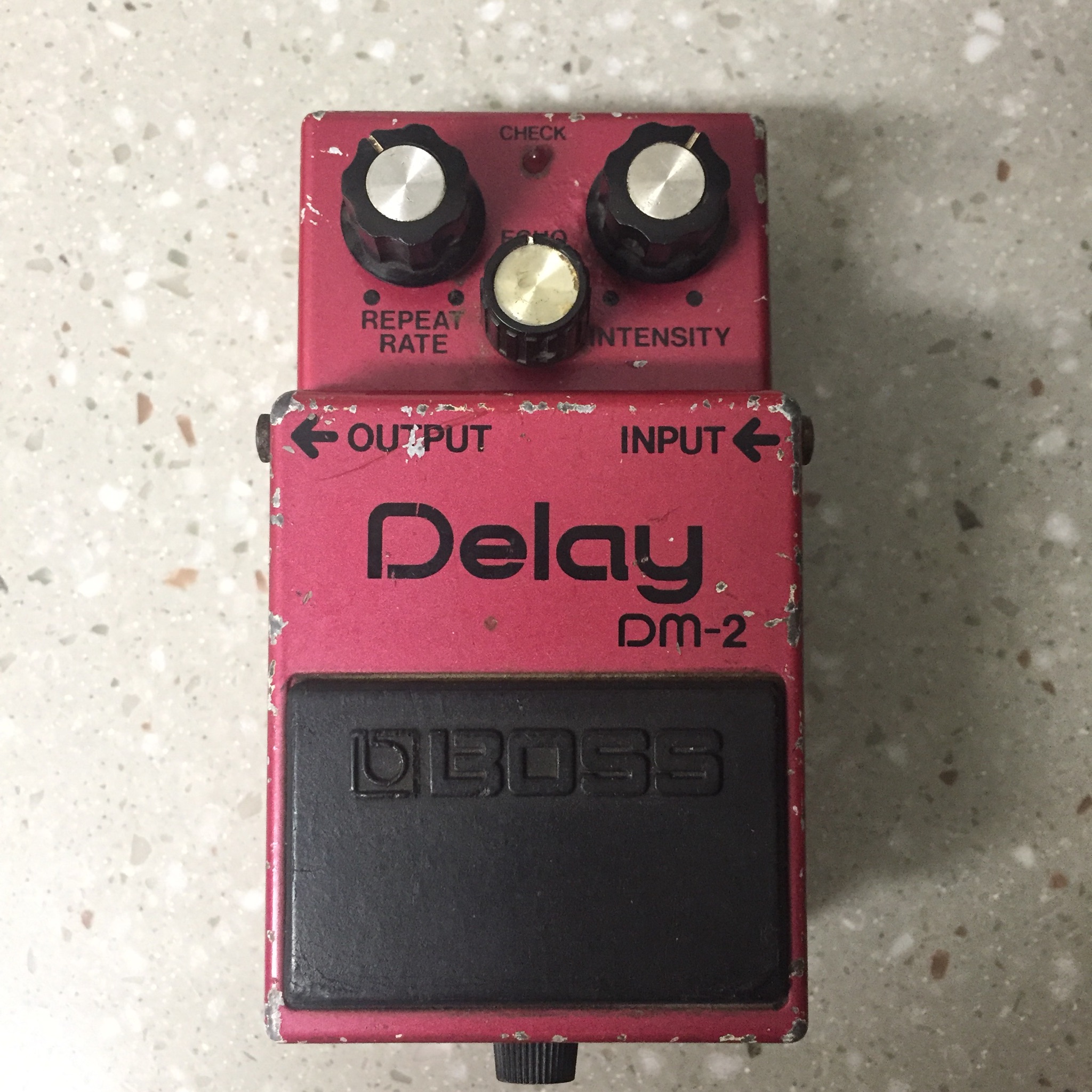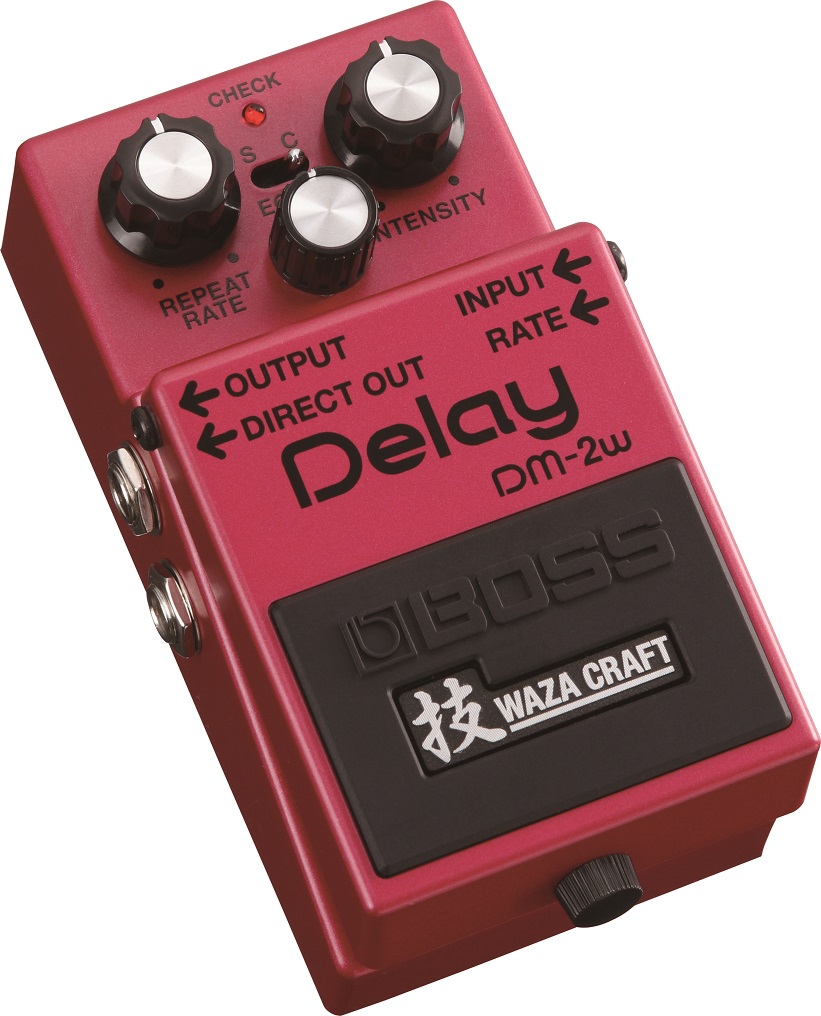 The Boss DM-2w Delay from the Waza Craft series is an all-analog and re-imagined pedal that is inspired from the original and highly-coveted Boss DM-2 Delay released in 1981. Unlike the vintage DM-2, the DM-2w Delay adds stereo output and has a custom switch which extends the delay time from the previous limit of 300 ms. to 800 ms.
The Boss DM-2w Delay from the Waza Craft series is an all-analog and re-imagined pedal that is inspired from the original and highly-coveted Boss DM-2 Delay released in 1981. Unlike the vintage DM-2, the DM-2w Delay adds stereo output and has a custom switch which extends the delay time from the previous limit of 300 ms. to 800 ms.
You may be thinking, “Well, why would Boss even need to add the switch? Why not just make it extend to 800 ms. by leting the user dial it in with the delay time control?”
This is where things get interesting. You see, the original DM-2 Delay is loved and coveted for its dirtier echo repeats. It not only has the common tone shift with each echo repeat as all analog delays do, but the degradation itself is also much more prominent and dark. When the DM-3 Delay was released in 1983, the goal was to make it cleaner and have less degradation to provide a smoother analog delay effect. Guess which pedal is preferred on the open market? You guessed it, the DM-2.
The DM-2w Delay in standard mode offers between 20-300 ms. of delay time and was made to mimic the dirtier echo repeats of the original. And of course, like the original DM-2, the DM-2w Delay is a pure analog circuit.
When the DM-2w is switched into Custom mode, the Delays are extended to 800 ms. but are also a bit cleaner. They certainly exhibit the tonal shift and degradation people love from an analog delay; it’s just not to the same degree as what can be found in Standard mode.
Personally I love analog delays because the tone shift and degradation qualities add interesting musical color to my playing. An echo in nature isn’t perfect and that’s also a form of analog by the way. As sounds bounce in a room or a cavern, the copy of the echo is also degraded and will shift in phase or tone as it moves.
Like the original DM-2 Delay, the DM-2w Delay has controls for Repeat Rate (Delay time), Echo (level mixes between dry and echo effect) and Intensity (number of echo repeats). Unlike the original DM-2 Delay, the DM-2w Delay adds a stereo direct output which splits the signal wet and dry for use with two amplifiers to obtain an even more spacious tone (an upgrade the DM-3 Delay also received when it first entered the market). The DM-2w can still of course also be used in mono which combines the wet and dry signal when using the Output jack by itself. An additional feature is the DM-2w’s expression pedal jack which can control the Rate level on the fly. Like all Boss pedals, it can be powered with a 9v battery or common negative tip 9v DC power supply.
Comparison #1: DM-2 vs DM-2w
Our Boss DM-2 delay is among one of the first made and is an early vintage model from 1981. These earliest designs used a BBD (Bucket Brigade Device) made by Panasonic called the MN3005. On a spec sheet, it is a BBD that features a better signal-to-noise ratio than the MN3205 chip which was equipped in later DM-2 and DM-3 units.
 I noticed that my DM-2 which was running on a battery was noticeably noisier than the DM-2w and had some interesting artifacts to the sounds when testing the vintage unit at a full 300 ms. and playing the highest and lowest notes on the guitar. The highest note on my Stratocaster was the E string 22nd fret and there was almost a ring-modulated out-of-tune tone added. In addition, the low E string echo at 300 ms. had some breathing/noise effects.
I noticed that my DM-2 which was running on a battery was noticeably noisier than the DM-2w and had some interesting artifacts to the sounds when testing the vintage unit at a full 300 ms. and playing the highest and lowest notes on the guitar. The highest note on my Stratocaster was the E string 22nd fret and there was almost a ring-modulated out-of-tune tone added. In addition, the low E string echo at 300 ms. had some breathing/noise effects.
I reached out to Mike Piera, a.k.a. Analogman, owner of Analogman Effects (www.buyanalogman.com), who is an expert on vintage pedals and he explained that there were likely two issues. First, the MN3005 chip requires more power than 9v, and indeed the early DC adapters from Boss were in fact 12v designs. Secondly, he also suggested that there could be an alignment issue with the delay.
Now, one “trick” that some people would do with their old delay pedals would be to open them up and play with the trim pots that were attached to the circuit board. These were never meant to be tampered with except by the engineers that built them. One of the trim pots will extend the delay time beyond 300 ms., but then the sound quality becomes very poor and even further broken up. The other pots align the delay time effect itself with the clock. So this is one area where buying an original vintage delay could be a bit costly, because the realignment of a delay costs money. And you never know who has been monkeying with an older pedal.
 After my discussion with Mike, I ran the original DM-2 on the proper 12v power supply and indeed it did improve. The extra noise artifacts were gone. The net result was the DM-2 maintained its classic, desirable dark and organic tone to it. It’s a great effect for short delays and slap back effects.
After my discussion with Mike, I ran the original DM-2 on the proper 12v power supply and indeed it did improve. The extra noise artifacts were gone. The net result was the DM-2 maintained its classic, desirable dark and organic tone to it. It’s a great effect for short delays and slap back effects.
NOW, when I compared the DM-2w in Standard mode, it did a great job emulating the original DM-2 with its 3005 chip, even though the DM-2w is equipped with a newer production 3205 BBD. Later original DM-2s were equipped with the 3205 BBD chip as well. In the end, the DM-2w captures what makes analog delay so much fun and enjoyable to play through.
Comparison #2: DM-3 vs. DM-2W
The DM-3 as explained earlier has a slightly cleaner signal and compression circuit added within it. It also uses the Panasonic MN3205 which Mike Piera explained is much more energy efficient and better suited for 9v use. I have to admit that there wasn’t a large difference between the DM-2 and DM-3 delays, but I could tell that the DM-3 was just a tad bit cleaner on its repeats.
When adding the DM-2w into the mix and setting it for Custom mode, I initially set the delay time and settings between it and the DM-3 to identical settings. I couldn’t hear any difference – and certainly if there were any, it would be in a frequency band well beyond what a guitar is capable of producing.
Now where the DM-2w jumped ahead was of course with its long delay times. The DM-3 stops at 300 ms. and I’ve always enjoyed delay effects around 500 ms. especially when layered in the background for use during guitar solos. That used to mean I’d need a digital delay, but with the advent of newer analog units not only from Boss, but other manufacturers, now players can get those natural decaying effects at long delay times. It’s truly a pleasure and I enjoyed the DM-2w’s capabilities with long delays immensely.
At $149 street, the Boss DM-2w Waza Craft Delay is fairly priced alongside its competition, and comes with a 5-year warranty and the Boss reputation for being rugged and reliable right out of the box. The Boss DM-2w is a fine addition to the Waza Craft family of pedals from Boss, and delivers a wide palette of vintage sounds as well as capabilities that bring it firmly into use for modern day musicians.